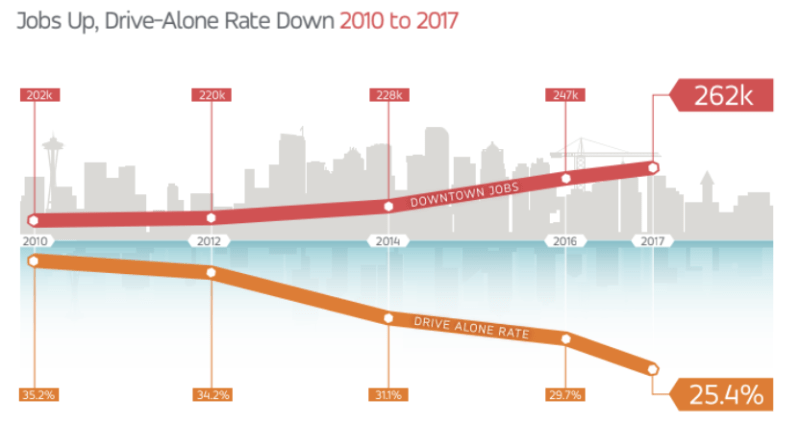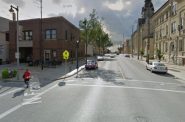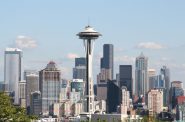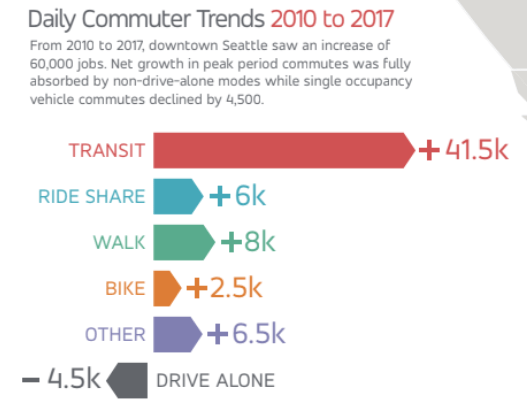Jobs Up Yet Driving Down in Seattle
Has added 60,000 downtown jobs, yet solo commuters declined 9%. Can Milwaukee learn from this?

Transit, biking, and walking — not car commuting — are absorbing job growth in downtown Seattle. Graphic: Commute Seattle
From 2010 to 2017, downtown Seattle added 60,000 jobs. Over the same time period, the number of solo car commuters into the city’s central business district dropped by 4,500, or 9 percent, according to a new report from Commute Seattle.
The city was able to absorb the employment boom without setting off a traffic explosion thanks mainly to a dramatic increase in transit ridership.
The number of transit commuters getting to work downtown has increased by 41,500 in the last seven years, a 48 percent increase. About half of all trips into downtown Seattle at rush hour are now made by bus or rail. Solo drivers account for just a quarter of downtown commuters.
Seattle’s remarkable performance was driven by major investments in transit. Since 2014, Seattle and King County have increased overall transit service 13 percent, fueled by strong support at the ballot box.
With three new Link light rail stations — including two that connect the University of Washington to downtown — the system is carrying 35,000 additional weekday trips since 2015, nearly doubling ridership. Those expansions were part of transit funding packages voters approved in 1996 and 2008.
By contrast, transit has greatly declined in Milwaukee: The Milwaukee County Transit System has seen ridership decline from more than 62 million in 2000 to about 40 million in 2016. During Scott Walker‘s years as Milwaukee County Executive funding for the system was regularly cut, as were a number routes, and fares rose significantly.
In 2014 Seattle voters approved a 0.1 percent sales tax hike and higher vehicle registration fees to add bus service within the city. As the city has added light rail service, it has systematically evaluated and adjusted its bus network to complement those changes. As a result, the share of Seattle residents living near frequent transit increased from about 25 percent in 2015 to 64 percent in 2017.
“People wanted more bus and light rail options, and we delivered,” said King County Executive Dow Constantine in a press release. “More service means more riders, and we will continue to make improvements to make it even easier to get downtown, and across the region.”
Recently, Milwaukee County Executive Chris Abele proposed an increase in the county wheel tax (vehicle registration fee) to $60 from $30 to help fund transit, but the Milwaukee County Board, led by board chair Theo Lipscomb, rejected the proposal due to strong opposition by residents who overwhelmingly voted against the increased wheel tax in a 2017 advisory referendum. The higher registration fee would have supplied an additional $15.6 million to the county’s budget this year. A cut in nine additional bus routes looked likely after the failure to raise additional funding, but an unexpected surplus of $481,000 generated by the existing registration fee held off those route cuts for now.
In 2016, voters in the Seattle region approved a 25-year transit funding package, which will add key connections in the city and roughly double the size of the rapid transit network.
Commute Seattle based its report on a survey of 1,784 downtown employees from randomly selected workplaces. Commute Seattle is a quasi-government organization that helps administer programs encouraging downtown workers to get around without private cars. It is supported by the city of Seattle, King County Metro, Sound Transit, and the Downtown Seattle Association.
Story by Angie Schmitt with additional contributions from Urban Milwaukee. A version of this story originally ran on Streetsblog. Angie Schmitt is a newspaper reporter-turned planner/advocate who manages the Streetsblog Network from glamorous Cleveland, Ohio. She also writes about urban issues particular to the industrial Midwest at Rustwire.com.
Streetsblog
-
Car Culture Cements Suburban Politics
![Sprawl. Photo by David Shankbone (David Shankbone) [GFDL (http://www.gnu.org/copyleft/fdl.html) or CC-BY-SA-3.0 (http://creativecommons.org/licenses/by-sa/3.0/)], via Wikimedia Commons [ https://commons.wikimedia.org/wiki/File%3ASuburbia_by_David_Shankbone.jpg ]](https://urbanmilwaukee.com/wp-content/uploads/2017/10/1024px-Suburbia_by_David_Shankbone-185x122.jpg) Nov 23rd, 2018 by Angie Schmitt
Nov 23rd, 2018 by Angie Schmitt
-
Most Drivers Don’t Yield to Pedestrians
 Mar 22nd, 2018 by Angie Schmitt
Mar 22nd, 2018 by Angie Schmitt
-
Seattle Adds People Without Adding Traffic
 Dec 20th, 2017 by Angie Schmitt
Dec 20th, 2017 by Angie Schmitt























There would have to be a focused effort to provide more support for walkability in the form of protection for pedestrians, better pedestrian crosswalks and intersections, and more enforcement of existing laws that protect pedestrians. This would help people feel comfortable taking transit and using walking and bicycling as transportation. Next, there would have to be a sober evaluation of the high cost of providing parking for cars in so many places at such low rates (including places where it is $0). Simply put, Milwaukee County spends a great deal of money accommodating drivers of cars, so it is no surprise that people drive cars. In this respect, it may be that Milwaukee County should be renamed the “Milwaukee Automobile Club,” because no expense seems to be spared to support drivers of cars at the cost of everything else including the viability of the park system, transportation choices, and the economic sustainability of the community.
Traffic in Seattle is an absolute nightmare. It’s vlrtually impossible to drive in the city. You cannot compare the density or geography of these two cities nor the level of new business investment. It’s so bad that Jeff Bezos has had private security shut down streets around the Amazon campus (my old neighborhood I grew up in that they changed the name of and bulldozed) just so HE can drive in and out! True story. I never had a car growing up in Seattle and pedaled eveywhere but those days are long gone. Cycling is way down with millenials in Seattle and this new Seattle is really only for the mega-rich and their minions. These minions, aka Amazombies and Brogrammers (who make up 50k of the 60k new workers downtown) live in the tiny overpriced, poorly built crap box “apodments” right near Amazon HQ, so no need to ride a bike, drive or take transit. Work is life, life is work. SLU?
Pray for Old Cascade!
Just askin–who’s going to be walking/riding bikes to work during the piercing cold snaps,snow/ice storms/rain and all forms of the lousy Wisconsin weather?
@JL Drost, pretty much everyone in Minneapolis and it’s even more cold and snowy!
BTW, it isn’t exactly pleasant rolling around Seattle in 25 degrees in freezing rain at all winter either.
But Mpls and Seattle are a lot different than Milwaukee in a whole lot of ways.
The question is posed: “Can Milwaukee learn from this?”
Sure. In fact we’ve already learned, especially those of us who have lived all over since the 1960’s, that Milwaukee is not Seattle (or Minneapolis, for that matter). It’s one of a kind, a great city to live in and to navigate cheaply and quickly.
Milwaukee is not generally populated by people who look to spend money foolishly on solutions to problems that don’t exist. Unless you are the Mayor, of course, and think a silly streetcar loop is going to make us “big time”.